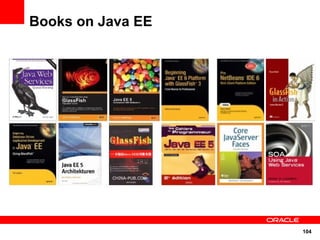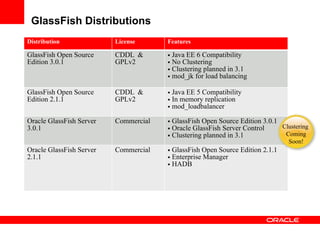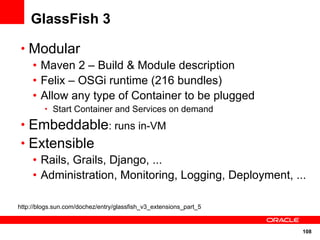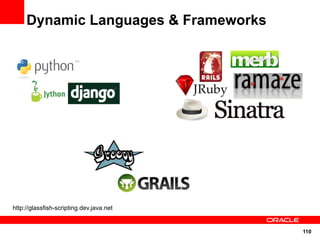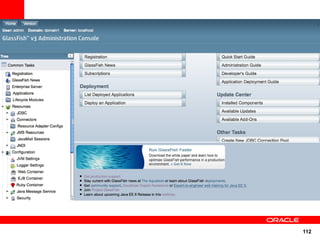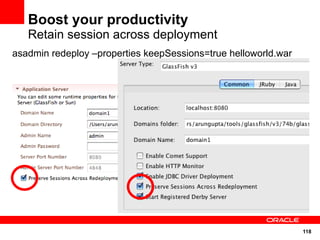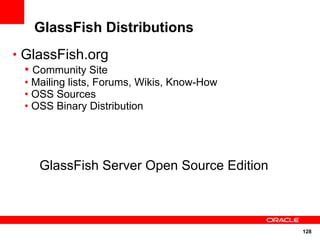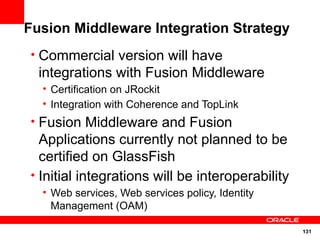JavaEE 6 and GlassFish v3 at SFJUG
- 1. <Insert Picture Here> Java EE 6 & GlassFish v3: Hands-on Workshop Arun Gupta, Java EE & GlassFish Guy blogs.sun.com/arungupta, @arungupta
- 2. The following/preceding is intended to outline our general product direction. It is intended for information purposes only, and may not be incorporated into any contract. It is not a commitment to deliver any material, code, or functionality, and should not be relied upon in making purchasing decisions. The development, release, and timing of any features or functionality described for Oracle’s products remains at the sole discretion of Oracle. 2
- 3. Are you tweeting ? #glassfish #sfjug 3
- 4. Java EE: Past & Present Flexible Ease of Development Java EE 6 Pruning Java EE 5 Extensibility Web Ease of Services Prof les i Development Annotations Ease-of-dev J2EE 1.4 EJB 3.0 EJB Lite Web Services, Persistence API RESTful WS Robustness Management, New and CDI Enterprise Deployment, Updated Java J2EE 1.3 Async. Web Services Platform CMP, Connector Connector Architecture ` Java EE 6 J2EE 1.2 Servlet, JSP, Web Prof le i EJB, JMS JPE RMI/IIOP Project Managed Bean 1.0 May 1998 Dec 1999 Sep 2001 Nov 2003 May 2006 Dec 2009 10 specs 13 specs 20 specs 23 specs 28 specs 4
- 5. Compatible Java EE 5 Impl http://java.sun.com/javaee/overview/compatibility-javaee5.jsp 5
- 6. Compatible Java EE 6 Impls Today: Announced: 6
- 7. Goals for the Java EE 6 Platform • Flexible & Light-weight • Extensible • Embrace Open Source Frameworks • Easier to use, develop on • Continue on path set by Java EE 5 7
- 8. Java EE 6 is Flexible • Decouple specs to allow more combinations • Expands potential licensee ecosystem • Profiles • Targeted bundle of technologies • Defined through the JCP • Web Profile Defined • Defined by the Java EE 6 Expert Group 8
- 9. Java EE 6 Web Profile 1.0 • Fully functional mid-sized profile • Actively discussed in the Java EE 6 Expert Group and outside it • Technologies • Servlets 3.0, JSP 2.2, EL 2.2, Debugging Support for Other Languages 1.0, JSTL 1.2, JSF 2.0, Common Annotations 1.1, EJB 3.1 Lite, JTA 1.1, JPA 2.0, Bean Validation 1.0, Managed Beans 1.0, Interceptors 1.1, Context & Dependency Injection 1.0, Dependency Injection for Java 1.0 9
- 10. Java EE 6 is Lightweight • Pruning • Make some technologies optional • Pruned today, means • Optional in the next release • Deleted in the subsequent releases • Technologies marked in Javadocs • JAX-RPC, EJB 2.x Entity Beans, JAXR, JSR 88 10
- 11. Java EE 6 - Done 09 • Specifications approved by the JCP • Reference Implementation is GlassFish v3 20 • TCK ec D 11
- 12. Java EE 6 Specifications • The Platform • Java EE 6 Web Profile 1.0 • Managed Beans 1.0 12
- 13. Java EE 6 Specifications New • Contexts and Dependency Injection for Java EE (JSR 299) • Bean Validation 1.0 (JSR 303) • Java API for RESTful Web Services (JSR 311) • Dependency Injection for Java (JSR 330) 13
- 14. Java EE 6 Specifications Extreme Makeover • Java Server Faces 2.0 (JSR 314) • Java Servlets 3.0 (JSR 315) • Java Persistence 2.0 (JSR 317) • Enterprise Java Beans 3.1 & Interceptors 1.1 (JSR 318) • Java EE Connector Architecture 1.6 (JSR 322) 14
- 15. Java EE 6 Specifications Updates • Java API for XML-based Web Services 2.2 (JSR 224) • Java API for XML Binding 2.2 (JSR 222) • Web Services Metadata MR3 (JSR 181) • JSP 2.2/EL 2.2 (JSR 245) • Web Services for Java EE 1.3 (JSR 109) • Common Annotations 1.1 (JSR 250) • Java Authorization Contract for Containers 1.3 (JSR 115) • Java Authentication Service Provider Interface for Containers 1.0 (JSR 196) 15
- 16. Java EE 6 Specifications As is • JDBC 4.0 API • Java Naming and Directory Interface 1.2 • Java Message Service 1.1 • Java Transaction API 1.1 • Java Transaction Service 1.0 • JavaMail API Specification 1.4 • JavaBeans Activation Framework 1.1 • Java API for XML Processing 1.3 • Java API for XML-based RPC 1.1 • SOAP with Attachments API for Java 1.3 • Java API for XML Registries 1.0 • Java EE Management Specification 1.1 (JSR 77) • Java EE Deployment Specification 1.2 (JSR 88) • Java Management Extensions 1.2 • Java Authentication and Authorization Service 1.0 • Debugging Support for Other Languages (JSR 45) • Standard Tag Library for JSP 1.2 (JSR 52) • Streaming API for XML 1.0 (JSR 173) 16
- 17. Managed Beans 1.0 EJB CDI JSF JAX-WS JAX-RS JPA ... @Stateful @Managed @Web @Stateless @Named @Path @Entity ... Bean Service @Singleton @javax.annotation.ManagedBean 17
- 18. Managed Beans 1.0 • POJO as managed component for the Java EE container • JavaBeans component model for Java EE • Simple and Universally useful • Advanced concepts in companion specs • Basic Services • Resource Injection, Lifecycle Callbacks, Interceptors • Available as • @Resource / @Inject • java:app/<module-name>/<bean-name> • java:module/<bean-name> 18
- 19. Managed Beans 1.0 - Sample @javax.annotation.ManagedBean @Resource public class MyManagedBean { MyManagedBean bean; @PostConstruct public void setupResources() { // setup your resources } @Inject @PreDestroy MyManagedBean bean; public void cleanupResources() { // collect them back here } public String sayHello(String name) { return "Hello " + name; } } http://blogs.sun.com/arungupta/entry/totd_129_managed_beans_1 19
- 20. Interceptors 1.1 • Interpose on invocations and lifecycle events on a target class • Defined • Using annotations or DD • On target class or an interceptor class associated with the target class • Default Interceptors (only in DD) • Class & Method Interceptors • Cross-cutting concerns: logging, auditing, profiling 20
- 21. Interceptors 1.1 - Code @InterceptorBinding @Retention(RetentionPolicy.RUNTIME) @Target({ElementType.METHOD, ElementType.TYPE}) public @interface MyInterceptorBinding { } @Interceptor @MyInterceptorBinding public class MyInterceptor { @AroundInvoke public Object intercept(InvocationContext context) { Object result = context.proceed(); return result; } . . . } 21
- 22. Interceptors 1.1 – Sample Code @Interceptors(MyInterceptor.class) public class MyManagedBean { . . . } @Inject MyManagedBean bean; @Interceptors({MyInterceptor.class, MyInterceptor2.class}) public class MyManagedBean { . . . } http://blogs.sun.com/arungupta/entry/totd_134_interceptors_1_1 22
- 23. Java EE 6 & Ease-of-development • Continue advancements of Java EE 5 • Primary focus: Web Tier • General principles • Annotation-based programming model • Reduce or eliminate need for DD • Traditional API for advanced users 23
- 24. Servlets in Java EE 5 At least 2 files <!--Deployment descriptor /* Code in Java Class */ web.xml --> <web-app> package com.sun; <servlet> public class MyServlet extends <servlet-name>MyServlet HttpServlet { </servlet-name> public void <servlet-class> doGet(HttpServletRequest com.sun.MyServlet req,HttpServletResponse res) </servlet-class> { </servlet> ... <servlet-mapping> <servlet-name>MyServlet } </servlet-name> ... <url-pattern>/myApp/* } </url-pattern> </servlet-mapping> ... </web-app> 24
- 25. Servlets 3.0 (JSR 315) Annotations-based @WebServlet package com.sun; @WebServlet(name=”MyServlet”, urlPatterns={”/myApp/*”}) public class MyServlet extends HttpServlet { public void doGet(HttpServletRequest req, HttpServletResponse res) { <!--Deployment descriptor web.xml --> <web-app> ... <servlet> <servlet-name>MyServlet</servlet-name> } <servlet-class> com.sun.MyServlet </servlet-class> </servlet> <servlet-mapping> <servlet-name>MyServlet</servlet-name> <url-pattern>/myApp/*</url-pattern> </servlet-mapping> ... </web-app> http://blogs.sun.com/arungupta/entry/totd_81_getting_started_with 25
- 26. Servlets 3.0 Annotations-based @WebServlet @WebServlet(name="mytest", urlPatterns={"/myurl"}, initParams={ @InitParam(name="n1", value="v1"), @InitParam(name="n2", value="v2") } ) public class TestServlet extends javax.servlet.http.HttpServlet { .... } 26
- 27. Servlets 3.0 Annotations-based @WebListeners <listener> <listener-class> server.LoginServletListener </listener-class> </listener> package server; . . . @WebListener() public class LoginServletListener implements ServletContextListener { 27
- 28. Servlets 3.0 Annotations-based @WebFilter <filter> <filter-name>PaymentFilter</filter-name> <filter-class>server.PaymentFilter</filter-class> <init-param> <param-name>param1</param-name> <param-value>value1</param-value> package server; </init-param> . . . </filter> @WebFilter( <filter-mapping> <filter-name>PaymentFilter</filter-name> filterName="PaymentFilter", <url-pattern>/*</url-pattern> InitParams={ </filter-mapping> @WebInitParam( <filter-mapping> <filter-name>PaymentFilter</filter-name> name="param1", <servlet-name>PaymentServlet</servlet-name> value="value1") <dispatcher>REQUEST</dispatcher> } </filter-mapping> urlPatterns={"/*"}, servletNames={"PaymentServlet"}, dispatcherTypes={DispatcherType.REQUEST} ) public class PaymentFilter implements Filter { . . . 28
- 29. Servlets 3.0 Asynchronous Servlets • Useful for Comet, long waits • Must declare @WebServlet(asyncSupported=true) AsyncContext context = request.startAsync(); context.addListener(new AsyncListener() { … }); context.dispatch(“/request.jsp”); //context.start(Runnable action); . . . context.complete(); http://blogs.sun.com/arungupta/entry/totd_139_asynchronous_request_processing 29
- 30. Servlets 3.0 Extensibility • Plugin libraries using web fragments • Modular web.xml • Bundled in framework JAR file in META-INF directory • Zero-configuration, drag-and-drop for web frameworks • Servlets, servlet filters, context listeners for a framework get discovered and registered by the container • Only JAR files in WEB-INF/lib are used 30
- 31. Servlets 3.0 Extensibility <web-fragment> <filter> <filter-name>wicket.helloworld</filter-name> <filter-class>org.apache.wicket.protocol.http.WicketFilter</filter-class> <init-param> <param-name>applicationClassName</param-name> <param-value>...</param-value> </init-param> </filter> <filter-mapping> <filter-name>wicket.helloworld</filter-name> <url-pattern>/*</url-pattern> </filter-mapping> </web-fragment> http://blogs.sun.com/arungupta/entry/totd_91_applying_java_ee 31
- 32. Servlets 3.0 Extensibility <web-fragment> <filter> <filter-name>LiftFilter</filter-name> <display-name>Lift Filter</display-name> <description>The Filter that intercepts lift calls</description> <filter-class>net.liftweb.http.LiftFilter</filter-class> </filter> <filter-mapping> <filter-name>LiftFilter</filter-name> <url-pattern>/*</url-pattern> </filter-mapping> </web-fragment> http://blogs.sun.com/arungupta/entry/totd_101_applying_servlet_3 32
- 33. Servlets 3.0 Extensibility - ServletContainerInitializer • Provided by the apps or container • Discovered using the service provider API • Expresses interest in classes via @HandlesTypes • Who uses it ? • Mojarra (JSF2) is bootstrapped into GlassFish • No “faces-config.xml” or “web.xml” • Jersey (JAX-RS) registers root Application • No (or portable) “web.xml” 33
- 34. Servlets 3.0 Dynamic Registration – Java Server Faces @SuppressWarnings({"UnusedDeclaration"}) @HandlesTypes({ ManagedBean.class, FacesComponent.class, FacesValidator.class, FacesConverter.class, FacesBehaviorRenderer.class, ResourceDependency.class, ResourceDependencies.class, ListenerFor.class, ListenersFor.class, UIComponent.class, Validator.class, Converter.class, Renderer.class }) public class FacesInitializer implements ServletContainerInitializer { // NOTE: Loggins should not be used with this class. private static final String FACES_SERVLET_CLASS = FacesServlet.class.getName(); 34
- 35. Servlets 3.0 Dynamic Registration – Java Server Faces public void onStartup(Set<Class<?>> classes, ServletContext servletContext) throws ServletException { if (shouldCheckMappings(classes, servletContext)) { Map<String,? extends ServletRegistration> existing = servletContext.getServletRegistrations(); for (ServletRegistration registration : existing.values()) { if (FACES_SERVLET_CLASS.equals(registration.getClassName())) { // FacesServlet has already been defined, so we're // not going to add additional mappings; return; } } ServletRegistration reg = servletContext.addServlet("FacesServlet", "javax.faces.webapp.FacesServlet"); reg.addMapping("/faces/*", "*.jsf", "*.faces"); servletContext.setAttribute(RIConstants.FACES_INITIALIZER_MAPPINGS_ADDED, Boolean.TRUE); 35
- 36. Servlets 3.0 Dynamic Registration – Create & Register • Create & Register • Performed during ServletContext initialization • ServletContext.add[Servlet | Filter] • Overloaded versions available ServletRegistration.Dynamic dynamic = servletContext.addServlet(“DynamicServlet”, “com.mycom.MyServlet); dynamic.addMapping(“/dynamicServlet”); dynamic.setAsyncSupported(true); 36
- 37. Servlets 3.0 Dynamic Registration – Lookup • ServletContext. get[Servlet |Filter]Registration(s) • Conflicts returned as java.util.Set ServletRegistration dynamic = servletContext. getServletRegistration(“DynamicServlet”); dynamic.addMapping(“/declaredServlet”); dynamic.setInitParameter(“param”, “value”); 37
- 38. Servlets 3.0 Resource Sharing • Static and JSP no longer confined to document root of the web application • May be placed in WEB-INF/lib/ [*.jar]/META-INF/resources • Resources in document root take precedence over those in bundled JAR myapp.war WEB-INF/lib/catalog.jar /META-INF/resources/catalog/books.html http://localhost:8080/myapp/catalog/books.html 38
- 39. Servlets 3.0 Much more ... • Programmatic authentication, login, logout > HttpServletRequest.authenticate > HttpServletRequest.login > HttpServletRequest.logout • File upload support • Servlet Security <error-page> <error-code>...</error-code> > @ServletSecurity <exception-type>...</exception-type> <location>/404.html</location> • Default Error Page </error-page> > Any HTTP status code > http://blogs.sun.com/arungupta/entry/ totd_136_default_error_page 39
- 40. EJB 3.1 (JSR 318) Package & Deploy in a WAR Java EE 5 Java EE 6 foo.war foo.ear WEB-INF/classes foo_web.war com.sun.FooServlet com.sun.TickTock WEB-INF/web.xml com.sun.FooBean WEB-INF/classes com.sun.FooHelper com.sun.FooServlet com.sun.TickTock foo_ejb.jar com.sun.FooBean web.xml ? com.sun.FooHelper http://blogs.sun.com/arungupta/entry/totd_95_ejb_3_1 40
- 41. EJB 3.1 • No interface view – one source file per bean • Only for Local and within WAR • Required for Remote • No location transparency • Component initialization in @PostConstruct • No assumptions on no-arg ctor 41
- 42. EJB 3.1 Portable Global JNDI Name Syntax • Portable • Global • Application/Module-scoped • Derived from metadata such as name, component name etc. 42
- 43. EJB 3.1 Portable Global JNDI Name Syntax Base name of ejb-jar/WAR Only within EAR (or ejb-jar.xml/web.xml) Base name of EAR (or application.xml) java:global[/<app-name>]/<module-name>/<bean-name> [!<fully-qualified-interface-name>] Unqualified name of the bean class • Until now, only java:comp Annotation/name attribute Or ejb-jar.xml • Local & Remote business • No-interface • Also in java:app, java:module 43
- 44. EJB 3.1 Embeddable API – Simple Bean @Stateless public class App { public String sayHello(String name) { return "Hello " + name; } } 44
- 45. EJB 3.1 Embeddable API – Deploy the Bean public void testEJB() throws NamingException { EJBContainer ejbC = EJBContainer.createEJBContainer(); Context ctx = ejbC.getContext(); App app = (App) ctx.lookup("java:global/classes/App"); assertNotNull(app); String NAME = "Duke"; String greeting = app.sayHello(NAME); assertNotNull(greeting); assertTrue(greeting.equals("Hello " + NAME)); ejbC.close(); } http://blogs.sun.com/arungupta/entry/totd_128_ejbcontainer_createejbcontainer_embedded 45
- 46. EJB 3.1 Singleton Beans • One instance per app/VM, not pooled • Useful for caching state • CMT/BMT • Access to container services for injection, resource manager, timers, startup/shutdown callbacks, etc. • Enable eager initialization using @Startup • Always supports concurrent access • Define initialization ordering using @Depends @Singleton public class MyEJB { . . . } 46
- 47. EJB 3.1 Asynchronous Session Beans • Light-weight JMS • Control returns to the client before the container dispatches the invocation to a bean instance • @Asynchronous – method or class • Return type – void or Future<V> • Transaction context does not propagate • REQUIRED → REQUIRED_NEW • Security principal propagates 47
- 48. EJB 3.1 Asynchronous Session Beans – Code Sample @Stateless @Asynchronous public class SimpleAsyncEJB { public Future<Integer> addNumbers(int n1, int n2) { Integer result; result = n1 + n2; try { // simulate JPA queries + reading file system Thread.currentThread().sleep(2000); } catch (InterruptedException ex) { ex.printStackTrace(); } return new AsyncResult(result); } } http://blogs.sun.com/arungupta/entry/totd_137_asynchronous_ejb_a 48
- 49. EJB 3.1 Timers • Automatically created EJB Timers • Calendar-based Timers – cron like semantics • Every Mon & Wed midnight @Schedule(dayOfWeek=”Mon,Wed”) • 2pm on Last Thur of Nov of every year (hour=”14”, dayOfMonth=”Last Thu”, month=”Nov”) • Every 5 minutes of every hour (minute=”*/5”, hour=”*”) • Every 10 seconds starting at 30 (second=”30/10”) • Every 14th minute within the hour, for the hours 1 and 2 am (minute=”*/14”, hour=”1,2”) 49
- 50. EJB 3.1 Timers • Single persistent timer across JVMs • Automatically created EJB Timers • @Schedule(hour=”15”,dayOfWeek=”Fri”) • Can be chained • @Schedules({ @Schedule(hour=”6”,dayOfWeek=”Tue,Thu,Fri-Sun”), @Schedule(hour=”12”,dayOfWeek=”Mon,Wed”) }) • May be associated with a TimeZone • Non-persistent timer, e.g. Cache • @Schedule(..., persistent=false) 50
- 51. EJB 3.1 EJB 3.1 Lite A proper subset of the full EJB 3.1 API that includes a small, powerful selection of EJB features suitable for writing portable transactional business logic ... suitable for inclusion in a wider range of Java products, many of which have much smaller installation and runtime footprints than a typical full Java EE implementation 51
- 52. EJB 3.1 EJB 3.1 Lite – Feature Comparison 52
- 53. Contexts & Dependency Injection (JSR 299) • Type-safe Dependency Injection • Builds on @Inject API • Context/Scope management • Works with multiple bean types • Includes ELResolver 53
- 54. CDI Injection Points • Field, Method, Constructor • 0 or more qualifiers Which one ? • Type (Qualifier) @Inject @LoggedIn User user Request What ? Injection (Type) 54
- 55. CDI Basics • Separate from @Resource but can co- exist • @Resource for container managed DI • @Inject for application managed DI • Strong typing, loose coupling • Clients only declare dependencies via injection points • Bean selection is done by CDI 55
- 56. CDI – Sample Client Code Field and Method Injection public class CheckoutHandler { @Inject @LoggedIn User user; @Inject PaymentProcessor processor; @Inject void setShoppingCart(@Default Cart cart) { … } } 56
- 57. CDI – Sample Client Code Constructor Injection public class CheckoutHandler { @Inject CheckoutHandler(@LoggedIn User user, PaymentProcessor processor, @Default Cart cart) { ... } } • Only one constructor can have @Inject 57
- 58. CDI - Sample Client Code Multiple Qualifiers and Qualifiers with Arguments public class CheckoutHandler { @Inject CheckoutHandler(@LoggedIn User user, @Reliable @PayBy(CREDIT_CARD) PaymentProcessor processor, @Default Cart cart) { ... } } 58
- 59. CDI - How to configure ? There is none! • Discovers bean in all modules in which CDI is enabled • Beans are automatically selected for injection • Possible to enable groups of bean selectively via a descriptor 59
- 60. CDI - Scopes • Beans can be declared in a scope • Everywhere: @ApplicationScoped, @RequestScoped • Web app: @SessionScoped • JSF app: @ConversarionScoped • Pseudo-scope (default): @Dependent • CDI runtime will make sure the right bean is created at the right time • Client do NOT have to be scope-aware 60
- 61. CDI - Named Beans Built-in support for the Unified EL • Beans give themselves a name with @Named(“cart”) • Then refer to it from a JSF or JSP page using the EL: <h:commandButton value=”Checkout” action=“#{cart.checkout}”/> 61
- 62. CDI - Events Even more decoupling • Annotation-based event model • A bean observes an event void onLogin(@Observes LoginEvent event){…} • Another bean fires an event @Inject @Any Event<PrintEvent> myEvent; void doPrint() { . . . myEvent.fire(new PrintEvent()); } • Events can have qualifiers too 62
- 63. CDI Much more ... • Producer methods and fields • Bridging Java EE resources • Alternatives • Interceptors • Decorators • Stereotypes 63
- 64. Java Server Faces 2.0 (JSR 314) • Facelets as “templating language” for the page • Custom components much easier to develop <html xmlns="http://www.w3.org/1999/xhtml" xmlns:ui="http://java.sun.com/jsf/facelets" xmlns:h="http://java.sun.com/jsf/html"> <h:head> <title>Enter Name & Password</title> </h:head> <h:body> <h1>Enter Name & Password</h1> <h:form> <h:panelGrid columns="2"> <h:outputText value="Name:"/> <h:inputText value="#{simplebean.name}" title="name" id="name" required="true"/> <h:outputText value="Password:"/> <h:inputText value="#{simplebean.password}" title="password" id="password" required="true"/> </h:panelGrid> <h:commandButton action="show" value="submit"/> </h:form> </h:body> </html> 64
- 65. JSF 2 Composite Components 65
- 66. JSF 2 Composite Components <html xmlns="http://www.w3.org/1999/xhtml" xmlns:ui="http://java.sun.com/jsf/facelets" xmlns:h="http://java.sun.com/jsf/html" xmlns:ez="http://java.sun.com/jsf/composite/ezcomp"> <h:head> <title>Enter Name & Password</title> </h:head> <h:body> <h1>Enter Name & Password</h1> <h:form> <ez:username-password/> <h:commandButton action="show" value="submit"/> </h:form> . . . </h:body> WEB-INF </html> index.xhtml resources/ ezcomp/ username-password.xhtml http://blogs.sun.com/arungupta/entry/totd_135_jsf2_custom_components 66
- 67. Java Server Faces 2.0 Integrated Ajax Support • f:ajax <h:commandButton actionListener="#{sakilabean.findActors}" value="submit"> <f:ajax execute="length" render="actorTable totalActors"/> </h:commandButton> http://blogs.sun.com/arungupta/entry/totd_123_f_ajax_bean 67
- 68. Java Server Faces 2.0 • “faces-config.xml” optional in common cases • <managed-bean> → @ManagedBean or @Named • Validator, Renderer, Listener, ... • Default navigation rules – match a view on the disk @Named(“simplebean”) public class SimpleBean { . . . } <h:commandButton action="show" value="submit"/> 68
- 69. Java Server Faces 2.0 Much more ... <navigation-case> <from-outcome>success</from-outcome> • Runs on Servlet 2.5+ <to-view-id>/page2.xhtml</to-view-id> <!-- Only accept if the following condition • Conditional navigation is true --> <if>#{foo.someCondition}</if> </navigation-case> • Project Stages • Development, UnitTest, SystemTest, Production • Custom Scopes for Managed Beans • Bookmarkable URLs • h:link, h:button <h:link outcome="viewEntry" value="Link"> <f:param name="entry" value="#{aBean.entry}"/> </h:link> <a href="http://localhost:8080/myapp/viewEntry.xhtml? entry=entry1">Link</a> 69
- 70. Java Persistence API 2 (JSR 317) Sophisticated mapping/modeling options • Collection of basic types @Entity public class Person { @Id protected String ssn; protected String name; protected Date birthDate; . . . @ElementCollection @CollectionTable(name=”ALIAS”) protected Set<String> nickNames; } 70
- 71. Java Persistence API 2 Sophisticated mapping/modeling options • Collection of embeddables @Embeddable public class Address { String street; String city; String state; . . . } @Entity public class RichPerson extends Person { . . . @ElementCollection protected Set<Address> vacationHomes; . . . } 71
- 72. Java Persistence API 2 Sophisticated mapping/modeling options • Multiple levels of embedding @Embeddable public class ContactInfo { @Embedded Address address; . . . } @Entity public class Employee { @Id int empId; String name; ContactInfo contactInfo; . . . } 72
- 73. Java Persistence API 2 Sophisticated mapping/modeling options • Improved Map support @Entity public class VideoStore { @Id Integer storeId; Address location; . . . @ElementCollection Map<Movie, Integer> inventory; } @Entity public class Movie { @Id String title; @String director; . . . } 73
- 74. Java Persistence API 2 Expanded JPQL • Support for all new modeling/mapping features • Operators and functions in select list • INDEX, KEY/VALUE ENTRY // Inventory is Map<Movie, Integer> SELECT v.location.street, KEY(i).title, VALUE(i), FROM VideoStore v JOIN v.inventory i WHERE KEY(i).director LIKE '%Hitchcock%' AND VALUE(i) > 0 74
- 75. Java Persistence API 2 Expaded JPQL – CASE Expression UPDATE Employee e SET e.salary = CASE e.rating WHEN 1 THEN e.salary * 1.05 WHEN 2 THEN e.salary * 1.02 ELSE e.salary * 0.95 END 75
- 76. Java Persistence API 2 Type-safe Criteria API EntityManager em = …; CriteriaBuilder cb = em.getCriteriaBuilder(); CriteriaQuery<ResultType> cquery = cb.createQuery(ResultType.class); Root<MyEntity> e = cquery.from(MyEntity.class); Join<MyEntity, RelatedEntity> j = e.join(…); … cquery.select(…) .where(…) .orderBy(…) .groupBy(…); TypedQuery<ResultType> tq = em.createQuery(cquery); List<ResultType> result = tq.getResultList(); 76
- 77. Java Persistence API 2 Caching • 1st-level Cache by PersistenceContext • Only one object instance for any database row • 2nd-level by “shared-cache-mode” • ALL, NONE • UNSPECIFIED – Provider specific defaults • ENABE_SELECTIVE - Only entities with Cacheable(true) • DISABLE_SELECTIVE - All but with Cacheable(false) • Optional feature for PersistenceProvider • Properties for find, refresh, setProperty • CacheRetrieveMode – USE, BYPASS 77
- 78. Java Persistence API 2 Metamodel • Abstract “schema-level” model over managed classes of a Persistence Context • Entities, Mapped classes, Embeddables, ... • Accessed dynamically • EntityManager or EntityManagerFactory.getMetamodel() • And/or statically materialized as metamodel classes • Use annotation processor with javac 78
- 79. Java Persistence API 2 Metamodel Example @Entity public class Customer { @Id Integer custId; String name; ... Address address; @ManyToOne SalesRep rep; @OneToMany Set<Order> orders; } import javax.persistence.metamodel.*; @StaticMetamodel(Customer.class) public class Customer_ { public static SingularAttribute<Customer, Integer> custId; public static SingularAttribute<Customer, String> name; public static SingularAttribute<Customer, Address> address; public static SingularAttribute<Customer, SalesRep> rep; public static SetAttribute<Customer, Order> orders; } 79
- 80. Java Persistence API 2 Much more ... • New locking modes • PESSIMISTIC_READ – grab shared lock • PESSIMISTIC_WRITE – grab exclusive lock • PESSIMISTIC_FORCE_INCREMENT – update version • em.find(<entity>.class, id, LockModeType.XXX) • em.lock(<entity>, LockModeType.XXX) • Standard configuration options • javax.persistence.jdbc.[driver | url | user | password] 80
- 81. Bean Validation (JSR 303) • Tier-independent mechanism to define constraints for data validation • Represented by annotations • javax.validation.* package • Integrated with JSF and JPA • JSF: f:validateRequired, f:validateRegexp • JPA: pre-persist, pre-update, and pre-remove • @NotNull(message=”...”), @Max, @Min, @Size • Fully Extensible • @Email String recipient; 81
- 82. Bean Validation Integration with JPA • Managed classes may be configured • Entities, Mapped superclasses, Embeddable classes • Applied during pre-persist, pre-update, pre- remove lifecycle events • How to enable ? • “validation-mode” in persistence.xml • “javax.persistence.validation.mode” key in Persistence.createEntityManagerFactory • Specific set of classes can be targeted • javax.persistence.validation.group.pre-[persist|update| remove] 82
- 83. Bean Validation Integration with JSF • Individual validators not required • Integration with EL • f:validateBean, f:validateRequired <h:form> <f:validateBean> <h:inputText value=”#{model.property}” /> <h:selectOneRadio value=”#{model.radioProperty}” > … </h:selectOneRadio> <!-- other input components here --> </f:validateBean> </h:form> 83
- 84. Bean Validation Programmatic Validation @Documented @Target({ANNOTATION_TYPE, METHOD, FIELD}) @Retention(RetentionPolicy.RUNTIME) @Constraint(validatedBy=CreditCardValidator.class) public @interface CreditCard { String message() default "Invalid card number"; Class<?>[] groups() default {}; Class<? Extends Payload>[] payload() default {}; } Control the order Metadata with in which constraints constraint declaration are applied 84
- 85. Bean Validation Programmatic Validation public class CreditCardValidator implements ConstraintValidator<CreditCard, String> { @Override public void initialize(CreditCard constraintAnnotation) { // possibly connect with the CreditCard backend service } @Override public boolean isValid(String value, ConstraintValidatorContext context) { Pattern pattern = Pattern.compile("dddd-dddd-dddd-dddd"); Matcher matcher = pattern.matcher(value); return matcher.matches(); } } 85
- 86. Bean Validation Programmatic Validation @Named(value=”shopping”) public class ShoppingService { @CreditCard String card; . . . } <h:inputText value="#{shopping.card}"/> 86
- 87. JAX-RS 1.1 • Java API for building RESTful Web Services • POJO based • Annotation-driven • Server-side API • HTTP-centric 87
- 88. JAX-RS 1.1 Code Sample - Simple @Path("helloworld") public class HelloWorldResource { @Context UriInfo ui; @GET @Produces("text/plain") public String sayHello() { return "Hello World"; } @Path("morning") public String morning() { return “Good Morning!”; } } 88
- 89. JAX-RS 1.1 Code Sample – Specifying Output MIME type @Path("/helloworld") @Produces("text/plain") public class HelloWorldResource { @GET public String doGetAsPlainText() { . . . } @GET @Produces("text/html") public String doGetAsHtml() { . . . } @GET } @Produces({ "application/xml", "application/json"}) public String doGetAsXmlOrJson() { . . . } 89
- 90. JAX-RS 1.1 Code Sample – Specifying Input MIME type @POST @Consumes("text/plain") public String saveMessage() { . . . } 90
- 91. JAX-RS 1.1 Code Sample import javax.inject.Inject; import javax.enterprise.context.RequestScoped; @RequestScoped public class ActorResource { @Inject DatbaseBean db; public Actor getActor(int id) { return db.findActorById(id); } } 91
- 92. JAX-RS 1.1 Code Sample import javax.ws.rs.GET; import javax.ws.rs.Path; import javax.ws.rs.Produces; import javax.ws.rs.PathParam; import javax.inject.Inject; import javax.enterprise.context.RequestScoped; @Path("/actor/{id}") @RequestScoped public class ActorResource { @Inject DatbaseBean db; @GET @Produces("application/json") public Actor getActor(@PathParam("id") int id) { return db.findActorById(id); } } http://blogs.sun.com/arungupta/entry/totd_124_using_cdi_jpa 92
- 93. JAX-RS 1.1 More Code Samples • Processing POSTed HTML Form @POST @Consumes("application/x-www-form-urlencoded") public void post(@FormParam("name") String name) { // Store the message } • Sub-Resources @Singleton @Path("/printers") public class PrintersResource { @GET @Path("/list") @Produces({"application/json", "application/xml"}) public WebResourceList getListOfPrinters() { ... } @GET @Path("/ids/{printerid}") @Produces({"application/json", "application/xml"}) public Printer getPrinter(@PathParam("printerid") String printerId) { ... } 93
- 94. JAX-RS 1.1 Integration with Java EE 6 – Servlets 3.0 • No or Portable “web.xml” <web-app> @ApplicationPath(“resources”) <servlet> <servlet-name>Jersey Web Application</servlet-name> public class MyApplication <servlet-class> extends com.sun.jersey.spi.container.servlet.ServletContainer javax.ws.rs.core.Application { </servlet-class> <init-param> } <param-name>javax.ws.rs.Application</param-name> <param-value>com.foo.MyApplication</param-value> </init-param> </servlet> <servlet-mapping> <servlet-name>Jersey Web Application</servlet-name> <url-pattern>/resources/*</url-pattern> </servlet-mapping> </web-app> 94
- 95. JAX-RS 1.1 Integration with Java EE 6 – EJB 3.1 • Use stateless or singleton EJBs in the WAR as resource and provider classes @Path(“stateless”) @Stateless @Singleton public class MyStatelessRootResource { public class MyStatelessResource { @Context UriInfo ui; @Context UriInfo ui; @GET … public String get() { return “GET”; } } @EJB MyStatelessResource subResource; @Path(“sub-resource”) public MyStatelessResource sub() { return subResource; } } 95
- 96. JAX-RS 1.1 Integration with Java EE 6 – Managed Beans • Inject Java EE or CDI-based dependencies in Resources @Path(“root”) @ManagedBean // Instantiated by EE container or CDI container // Managed by JAX-RS container in the per-request scope public class RootResource { @Context UriInfo ui; @Resource(name="pi") double pi; … } 96
- 97. JAX-RS 1.1 Integration with Java EE 6 – CDI • Resource class instantiated and managed by CDI @Path(“root”) @ApplicationScoped @RequestScoped public class SubResource { // Instantiated and managed by the CDI container @Context UriInfo ui; public class RootResource { @Context UriInfo ui; … } @Inject double pi; @Inject Provider<SubResource> subResource; @Path(“sub-resource”) public SubResource sub() { return subResource.get(); } } 97
- 98. JAX-RS 1.1 Jersey Client-side API • Consume HTTP-based RESTful Services • Easy-to-use • Better than HttpURLConnection! • Reuses JAX-RS API • Resources and URI are first-class citizens • Not part of JAX-RS yet • com.sun.jersey.api.client 98
- 99. JAX-RS 1.1 Jersey Client API – Code Sample Client client = Client.create(); WebResource resource = client.resource(“...”); //curl http://example.com/base String s = resource.get(String.class); //curl -HAccept:text/plain http://example.com/base String s = resource. accept(“text/plain”). get(String.class); http://blogs.sun.com/enterprisetechtips/entry/consuming_restful_web_services_with 99
- 100. JAX-RS 1.1 Jersey Client API – NetBeans Code Generation 100
- 101. JAX-RS 1.1 WADL Representation of Resources • Machine processable description of HTTP-based Applications • Generated OOTB for the application <application xmlns="http://research.sun.com/wadl/2006/10"> <doc xmlns:jersey="http://jersey.dev.java.net/" jersey:generatedBy="Jersey: 1.1.4.1 11/24/2009 01:37 AM"/> <resources base="http://localhost:8080/HelloWADL/resources/"> <resource path="generic"> <method id="getText" name="GET"> <response> <representation mediaType="text/plain"/> </response> </method> <method id="putText" name="PUT"> <request> <representation mediaType="text/plain"/> </request> </method> </resource> </resources> </application> 101
- 102. JAX-RS 1.1 Much more ... • Jersey is the Reference Implementation, included in GlassFish • RESTEasy, Restlet, CXF, Wink • Hypermedia support (only in Jersey) • Integration with Spring, Guice, Atom, … • WADL representation • Complete, Per resource • Jersey 1.2 modules are OSGi compliant 102
- 103. IDE Support for Java EE 6 103
- 104. Books on Java EE 104
- 106. What is GlassFish ? • A community • Users, Partners, Testers, Developers, ... • Started in 2005 on java.net • Application Server • Open Source (CDDL & GPL v2) • Java EE Reference Implementation 106
- 107. GlassFish Distributions Distribution License Features GlassFish Open Source CDDL & • Java EE 6 Compatibility Edition 3.0.1 GPLv2 • No Clustering • Clustering planned in 3.1 • mod_jk for load balancing GlassFish Open Source CDDL & • Java EE 5 Compatibility Edition 2.1.1 GPLv2 • In memory replication • mod_loadbalancer Oracle GlassFish Server Commercial • GlassFish Open Source Edition 3.0.1 3.0.1 • Oracle GlassFish Server Control Clustering • Clustering planned in 3.1 Coming Soon! Oracle GlassFish Server Commercial • GlassFish Open Source Edition 2.1.1 2.1.1 • Enterprise Manager • HADB
- 108. GlassFish 3 • Modular • Maven 2 – Build & Module description • Felix – OSGi runtime (216 bundles) • Allow any type of Container to be plugged • Start Container and Services on demand • Embeddable: runs in-VM • Extensible • Rails, Grails, Django, ... • Administration, Monitoring, Logging, Deployment, ... http://blogs.sun.com/dochez/entry/glassfish_v3_extensions_part_5 108
- 109. GlassFish 3 & OSGi • No OSGi APIs are used in GlassFish • HK2 provides abstraction layer • All GlassFish modules are OSGi bundles • Felix is default, also runs on Knopflerfish & Equinox • Can run in an existing shell • 200+ modules in v3 http://blogs.sun.com/arungupta/entry/totd_103_glassfish_v3_with 109
- 110. Dynamic Languages & Frameworks http://glassfish-scripting.dev.java.net 110
- 111. Demo NetBeans / Eclipse & Java EE 6 http://blogs.sun.com/arungupta/entry/screencast_27_simple_web_application http://blogs.sun.com/arungupta/entry/screencast_28_simple_web_application http://blogs.sun.com/arungupta/entry/screencast_26_develop_run_debug/ http://blogs.sun.com/arungupta/entry/totd_93_getting_started_with/ http://blogs.sun.com/arungupta/entry/totd_94_a_simple_java http://blogs.sun.com/arungupta/entry/totd_95_ejb_3_1 http://blogs.sun.com/arungupta/entry/totd_102_java_ee_6 http://blogs.sun.com/arungupta/entry/totd_99_creating_a_java 111
- 112. 112
- 113. Demo GlassFish 3 Administration 113
- 114. Light Weight & On-demand Monitoring • Event-driven light-weight and non-intrusive monitoring • Modules provide domain specific probes (monitoring events) • EJB, Web, Connector, JPA, Jersey, Orb, Ruby • End-to-end monitoring on Solaris using DTrace • 3rd party scripting clients • JavaScript to begin with 114
- 115. Demo GlassFish 3 Monitoring http://blogs.sun.com/arungupta/entry/totd_104_glassfish_v3_monitoring 115
- 116. REST Interface • REST interface to management and monitoring data • Configuration data, commands invocation, (start/stop instance, deploy, undeploy, ...), CRUD resources (JMS, JDBC, ...) •localhost:4848/management/domain •localhost:4848/monitoring/domain • GET, POST, DELETE methods • XML, JSON, HTML reps 116
- 117. Demo GlassFish 3 REST Interface http://blogs.sun.com/arungupta/entry/totd_113_javafx_front_end http://blogs.sun.com/arungupta/entry/totd_116_glassfish_v3_administration 117
- 118. Boost your productivity Retain session across deployment asadmin redeploy –properties keepSessions=true helloworld.war 118
- 120. Books on GlassFish 120
- 121. GlassFish 3 Performance http://weblogs.java.net/blog/sdo/archive/2009/12/08/first-look-v3-performance 121
- 122. GlassFish 3 Performance http://weblogs.java.net/blog/sdo/archive/2009/12/08/first-look-v3-performance 122
- 123. GlassFish 3.0.1 • First Oracle-branded release of GlassFish • Additional platform support • Oracle Enterprise Linux 4 & 5 (32 & 64-bit) • Red Hat Enterprise Linux 64-bit • Window 2008 R2 (32 & 64-bit) • HP-UX 11i, (32 & 64-bit) • JRockit 6 Update 17 • 100+ bugfixes http://www.oracle.com/technetwork/middleware/glassfish/overview/index.html 123
- 124. GlassFish 3.1 • Main Features • Clustering and Centralized Administration • High Availability • Other ... • Application Versioning • Embedded (extensive) • Admin Console based on RESTful API http://wikis.sun.com/display/glassfish/GlassFishv3.1 124
- 126. GlassFish Roadmap • Oracle committed to GlassFish community • No changes to the operation of GlassFish OSS • Remains transparent and participatory • GlassFish strengthened by Oracle stewardship • Oracle wants to grow the community • Customer and community driven roadmap http://glassfish.org/roadmap 126
- 127. GlassFish Roadmap Detail 127 ©2010 Oracle Corporation
- 128. GlassFish Distributions • GlassFish.org • Community Site • Mailing lists, Forums, Wikis, Know-How • OSS Sources • OSS Binary Distribution GlassFish Server Open Source Edition 128
- 129. GlassFish Distributions • Oracle.com • Commercial Site • Formal documentation and Support • Includes Value-adds • Oracle distribution with standard Oracle Licenses • Evaluation – OTN Evaluation License • Production – Deployment License Oracle GlassFish Server 129
- 130. Key Changes Under Oracle • Not Changed • Open Source (most GPL/CDDL) • Non-Oracle committers • Transparent development • OSS binaries at glassfish.org • Not Changed • Add-ons remain closed source • Changed • New licenses at oracle.com for Trial and Deployment • Add-ons easier to try and bundled in Oracle distribution 130
- 131. Fusion Middleware Integration Strategy • Commercial version will have integrations with Fusion Middleware • Certification on JRockit • Integration with Coherence and TopLink • Fusion Middleware and Fusion Applications currently not planned to be certified on GlassFish • Initial integrations will be interoperability • Web services, Web services policy, Identity Management (OAM) 131
- 132. References • glassfish.org • blogs.sun.com/theaquarium • oracle.com/goto/glassfish • glassfish.org/roadmap • youtube.com/user/GlassFishVideos • Follow @glassfish 132
- 133. <Insert Picture Here> Java EE 6 & GlassFish v3: Paving the path for the future Arun Gupta, Java EE & GlassFish Guy blogs.sun.com/arungupta, @arungupta


















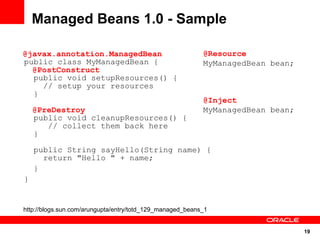

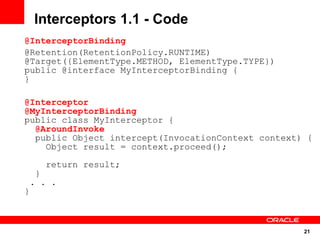






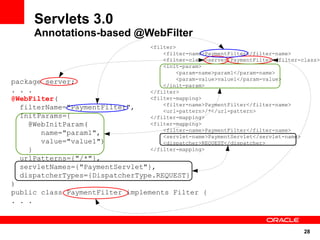

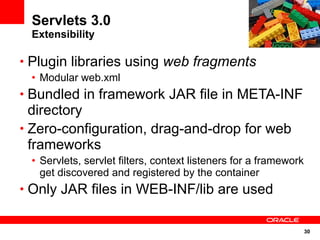

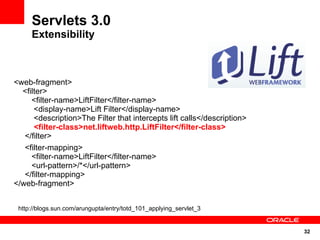

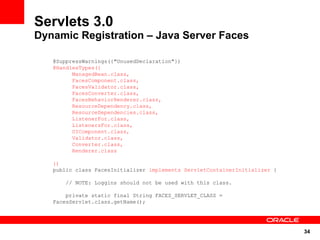

![Servlets 3.0
Dynamic Registration – Create & Register
• Create & Register
• Performed during ServletContext initialization
• ServletContext.add[Servlet | Filter]
• Overloaded versions available
ServletRegistration.Dynamic dynamic =
servletContext.addServlet(“DynamicServlet”,
“com.mycom.MyServlet);
dynamic.addMapping(“/dynamicServlet”);
dynamic.setAsyncSupported(true);
36](https://image.slidesharecdn.com/javaee6-glassfishv3-sfjug-100811110706-phpapp02/85/JavaEE-6-and-GlassFish-v3-at-SFJUG-36-320.jpg)
![Servlets 3.0
Dynamic Registration – Lookup
• ServletContext.
get[Servlet |Filter]Registration(s)
• Conflicts returned as java.util.Set
ServletRegistration dynamic = servletContext.
getServletRegistration(“DynamicServlet”);
dynamic.addMapping(“/declaredServlet”);
dynamic.setInitParameter(“param”, “value”);
37](https://image.slidesharecdn.com/javaee6-glassfishv3-sfjug-100811110706-phpapp02/85/JavaEE-6-and-GlassFish-v3-at-SFJUG-37-320.jpg)
![Servlets 3.0
Resource Sharing
• Static and JSP no longer confined to
document root of the web application
• May be placed in WEB-INF/lib/
[*.jar]/META-INF/resources
• Resources in document root take
precedence over those in bundled JAR
myapp.war
WEB-INF/lib/catalog.jar
/META-INF/resources/catalog/books.html
http://localhost:8080/myapp/catalog/books.html
38](https://image.slidesharecdn.com/javaee6-glassfishv3-sfjug-100811110706-phpapp02/85/JavaEE-6-and-GlassFish-v3-at-SFJUG-38-320.jpg)

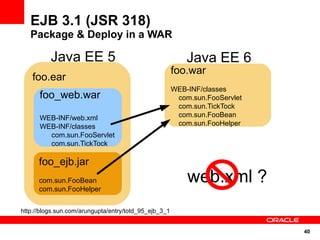
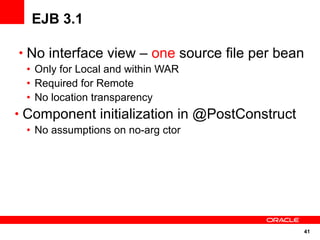

![EJB 3.1
Portable Global JNDI Name Syntax
Base name of ejb-jar/WAR
Only within EAR (or ejb-jar.xml/web.xml)
Base name of EAR
(or application.xml)
java:global[/<app-name>]/<module-name>/<bean-name>
[!<fully-qualified-interface-name>]
Unqualified name of the bean class
• Until now, only java:comp Annotation/name attribute
Or ejb-jar.xml
• Local & Remote business
• No-interface
• Also in java:app, java:module
43](https://image.slidesharecdn.com/javaee6-glassfishv3-sfjug-100811110706-phpapp02/85/JavaEE-6-and-GlassFish-v3-at-SFJUG-43-320.jpg)
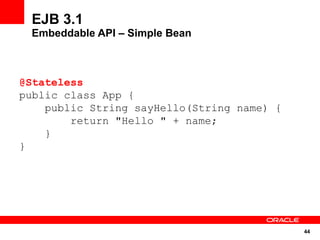
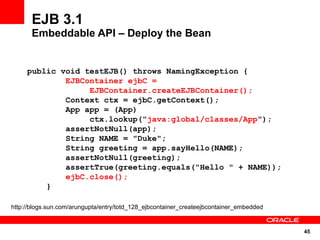




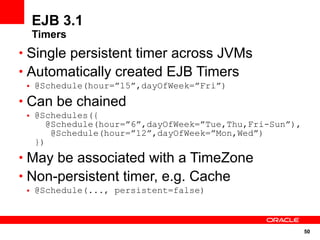

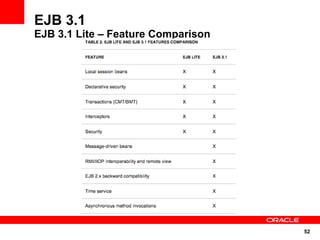
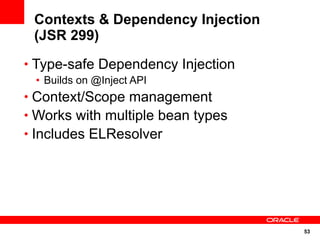










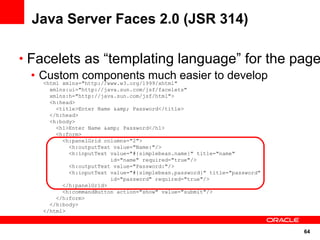









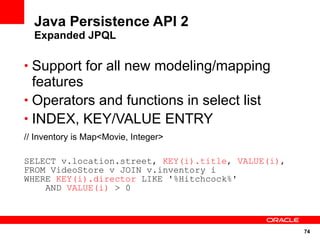

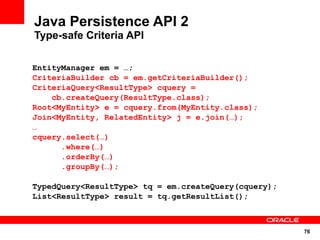

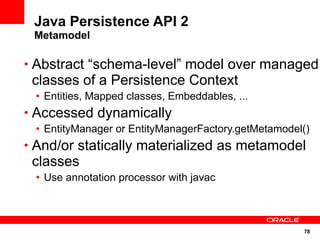
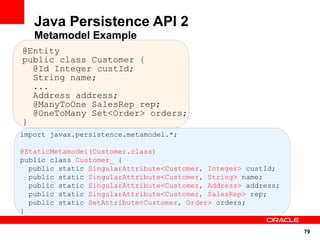
![Java Persistence API 2
Much more ...
• New locking modes
• PESSIMISTIC_READ – grab shared lock
• PESSIMISTIC_WRITE – grab exclusive lock
• PESSIMISTIC_FORCE_INCREMENT – update version
• em.find(<entity>.class, id,
LockModeType.XXX)
• em.lock(<entity>, LockModeType.XXX)
• Standard configuration options
• javax.persistence.jdbc.[driver | url | user | password]
80](https://image.slidesharecdn.com/javaee6-glassfishv3-sfjug-100811110706-phpapp02/85/JavaEE-6-and-GlassFish-v3-at-SFJUG-80-320.jpg)

![Bean Validation
Integration with JPA
• Managed classes may be configured
• Entities, Mapped superclasses, Embeddable classes
• Applied during pre-persist, pre-update, pre-
remove lifecycle events
• How to enable ?
• “validation-mode” in persistence.xml
• “javax.persistence.validation.mode” key in
Persistence.createEntityManagerFactory
• Specific set of classes can be targeted
• javax.persistence.validation.group.pre-[persist|update|
remove]
82](https://image.slidesharecdn.com/javaee6-glassfishv3-sfjug-100811110706-phpapp02/85/JavaEE-6-and-GlassFish-v3-at-SFJUG-82-320.jpg)

![Bean Validation
Programmatic Validation
@Documented
@Target({ANNOTATION_TYPE, METHOD, FIELD})
@Retention(RetentionPolicy.RUNTIME)
@Constraint(validatedBy=CreditCardValidator.class)
public @interface CreditCard {
String message() default "Invalid card number";
Class<?>[] groups() default {};
Class<? Extends Payload>[] payload() default {};
}
Control the order Metadata with
in which constraints constraint declaration
are applied
84](https://image.slidesharecdn.com/javaee6-glassfishv3-sfjug-100811110706-phpapp02/85/JavaEE-6-and-GlassFish-v3-at-SFJUG-84-320.jpg)



















